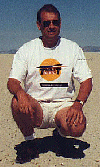

|
Nick Chapman and Robin Richardson |

|
In the last issue we covered some of the key people in the Thrust team and here we continue that theme. The Thrust team works in a way that is unlike most motor racing outfits. For a start, most of its members have 'day jobs' although many work in areas closely connected to their roles in the team. As the project has moved through the various stages of concept, research, design and build, so the make up of the team has evolved to cater for the current work that needs doing. This evolution is a major strength in that new people bring new skills, attitudes and levels of enthusiasm that complement those already in place. This regeneration will continue as the process moves on towards actually running the car, but in the meantime here is a brief run down of some of those involved.
In this issue ...
 GLYNNE BOWSHER
GLYNNE BOWSHERAs he welcomes you into his home in a village near Solihull in the West Midlands, Glynne apologises for things being everywhere. "If I ever get some free time, I will unpack these boxes and start on the decorating!" says Glynne. But in the 18 months since the Bowshers moved in, Glynne has spent nearly all of his spare time in front of his CAD computer designing the mechanical components of ThrustSSC. Originally from Newport in Gwent, Glynne has worked in the Birmingham area for over 30 years. "I had an apprenticeship with Girling Brakes in South Wales, who then sponsored me for a degree in Mechanical Engineering at Cardiff University" he recalls. "But between terms, I had a summer job at Girling's main offices at Tyseley in Birmingham, and I'm still here!". Glynne now works for Lucas Automotive, who took over Girling some time ago, but he still works on advanced braking and brake control systems. Lucas are generously sponsoring Glynneís time on the project.
It is because of his expertise on brakes, that Glynne first met Richard Noble when he was working on the Thrust 2 project. "Richard wrote to Girling and asked if they would be interested in looking at the braking system required for a Land Speed Record car and I was lucky enough to be assigned to the task." Glynne not only designed Thrust 2's successful braking system, he also helped chief designer, John Ackroyd, with the finite stress analysis of the vehicle. As a key member of the Thrust 2 team, Glynne was with Richard Noble at Bonneville in 1981, and at Black Rock in 1982 and 1983. "I was there on the day that Richard broke the record", he remembers. "There was such elation that the record had finally been broken, but I also recall thinking about all the build up and effort that had gone into the project was now over in a run that only lasted a few seconds!" Being an avid photographer, Glynne has a large collection of pictures of the Thrust 2 project. "I must unpack that box sometime", he adds!!!
The members of the Thrust 2 team still get together every year, and it was at one of these reunions about five years ago that Richard took Glynne to one side and casually asked him about the stresses in wheels the size of Thrust 2's revolving at 10,000 rpm, instead of the 7,300 rpm. Glynne was hooked! Thrust 2's wheels certainly couldn't cope with the rotational speeds involved. After much puzzling, lots of research and several brainwaves, Glynne had a design for the job. It was only then that Richard introduced Glynne to Ron Ayers and came clean with his plans for a new attempt on the record! "Ron sent me his drawings for ThrustSSC, which at that time was an aerodynamic shape on four wheels! There were many challenges with trying to get the front wheels to steer the vehicle". Glynne's eyes twinkle as he explains the intricacies of suspension mountings and increased cross-sectional area. "But the biggest reason is that wheels that are 34 inches in diameter, weigh 250 pounds and turn at 8,500 rpm turn into giant gyroscopes when you try to steer them. The forces generated would be enough to lift one side of the car off the ground, and bury the other side into the desert!" Glynne's solution was simple - steer the rear wheels! And he set about building a 2.55:1 scale research vehicle to prove the concept. The modified Mini was very successful in its test drives around the MIRA test track - you can see a picture of it on the BBC poster. ThrustSSC was well and truly underway!
When asked what he does on ThrustSSC, Glynne will say quietly and modestly "Oh, not much." But stand back and look at the magnificent job he's done in designing the wheels and bearings, the steering and suspension, the brakes and even the space frame itself, Glynne's contribution to the project is quite extraordinary.
So what other interests does Glynne have - high tech machines? motor racing, perhaps? "No, motor racing bores me stiff" he laughs. "I've been twice - once to Goodwood when I was 14, and once to Silverstone for a Thrust 2 reunion in 1991. Same reaction, both times!!" One of Glynne's pet interests is Industrial Archeology, as his work room at home testifies. It is crammed full of books, models, drawings, pictures .... and boxes!!
 JOHN ROWLES
JOHN ROWLESAlong with partner Greg Tallett, John joined the project right at the beginning as a result of a chance meeting with Richard Noble when he was looking for Speys. He has served in the RAF for 20 years working on a whole range of aircraft from Wessex helicopters, through to Phantoms and Tornadoes. The demands of his daytime RAF job, producing technical documents for aircraft maintenance, means that John cannot devote as much time to the project of late as he would like. Nevertheless, he and Greg have made a lasting contribution to the project with the testbed running of the two Spey 202 engines, and the design of the engine installations in ThrustSSC. We hope that they will be able to spend more time with the project if their RAF commitments allow it.
 MIKE HORNE
MIKE HORNEMike is an independent design engineer specialising in composite construction. From 1965 until 1983 he founded and ran a boat building company supplying the Army, Navy, and even the Royal Yacht Britannia, via the Ministry of Defence. As techniques developed around the use of composites, Mikeís work followed suit and apart from ThrustSSC, he has projects underway with the likes of BP, Shell, British Gas and BT. The huge composite programme is a vast undertaking which has been run by Mike almost single handed. The quality of his work is quite outstanding-you only have to look at the ThrustSSC nose and nacelles to realise why Mikeís work is regarded so highly.
 BRIAN PALMER
BRIAN PALMERBrian came to the project via Plane Trucking, the transport organisation who have taken care of moving the engines, the SSC mock up, and now the completed structure of SSC around the country. Just released by them more or less full time for the foreseeable future, Brianís crucial role in the project is the management of all movements whether by road or by air and at present he is collecting all the project equipment and engines into Q Shed and leading the Mach 1 team which is building up the teamís insulated air-conditioned 40ft computer systems desert truck.
 PETER ROSS
PETER ROSSBy profession, Peter is a gas turbine/airframe systems engineer and has many years of experience with British Airways and the RAF. His technical background makes him the ideal Project Engineering Coordinator and as such he has to ensure that all the activities take place on time and to specification. Such things as parts acquisition & collection, progress chasing, data storage of product weights and all the engineering administration are vital given the short build time frame.
The SSC team will be using a number of all wheel drive Supacat all terrain vehicles in a variety of support roles while on the desert, so it should come as no surprise that Mike heads up the company that looks after the marketing of these tough and versatile vehicles outside the UK. Part of the original Thrust2 team, Mike also has in depth experience of just what it takes to break the LSR. Apart from handling logistics for the desert support operation, Mike has been kept constantly busy with his wife Ninnetta organising and staging the highly successful ThrustSSC Roadshows.
A new recruit to the team, Kanti is working under the guidance of vehicle systems designer Jeremy Bliss, to produce and fit all of the electronic hardware that will ensure that the complex and all important systems function correctly. Wherever there is a sensor, transducer, junction box or whatever, thatís where youíll find Kantiís skills being applied.
Another ex Thrust 2 man back in the fold is Bruce White. Retirement has its attractions, but when youíve been involved in something as exciting as the LSR itís difficult to resist the temptation when it comes along. Having done such an excellent job with the parachutes on Thrust 2, it was natural that Richard should seek his advice when it came to ThrustSSC. Advice quickly became full involvement, along with that all important experience of actually having been there before.
 ANDREW NOBLE
ANDREW NOBLEA versatile lot these Nobles! Andrew lives in France and does exciting things with yachts to earn a crust. Oh, and by the way, yes he is Richardís brother. Yet another ex Thrust 2 man (he drove the transporter last time), Andrew has been responsible for all the on the ground research connected with the worldwide search for another desert comparable with Black Rock. Described by Richard as the ‘overseas Mr Fixití Andrew is frequently either on a plane or planning to be on a plane to somewhere. Apart from a sense of determination shared with Richard, he has a lively sense of humour and the knowledge to make critical decisions about suitability of possible desert surfaces based on a number of years working with Thrust 2 at Black Rock.
More team members in the next issue.
 |
 |
 |
||
| Sponsored by | This site best viewed with Microsoft Internet Explorer 3 | |||